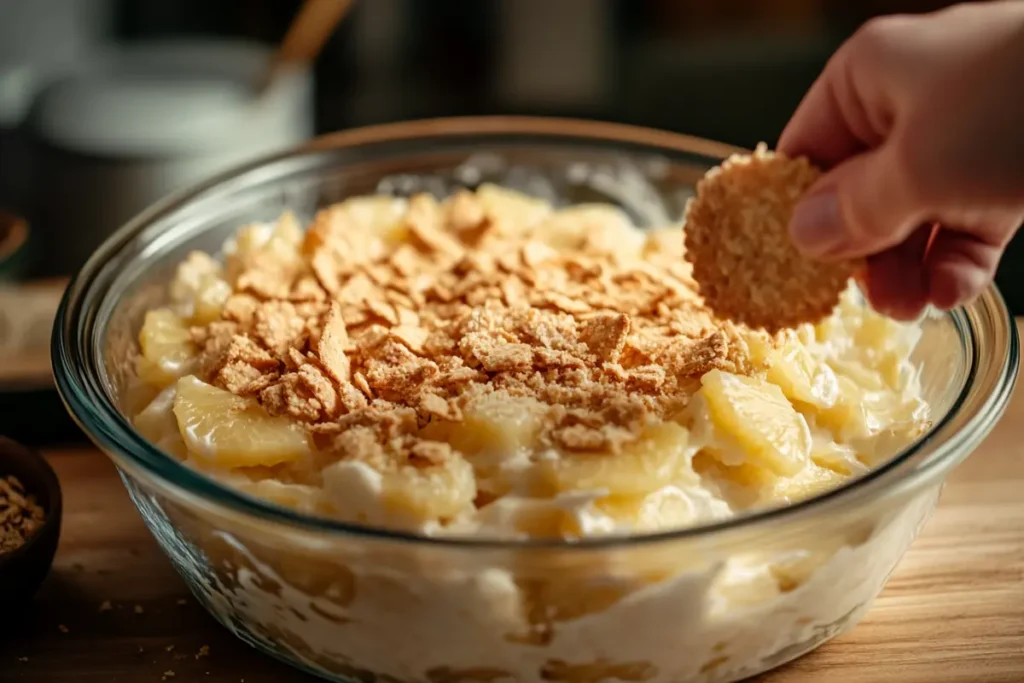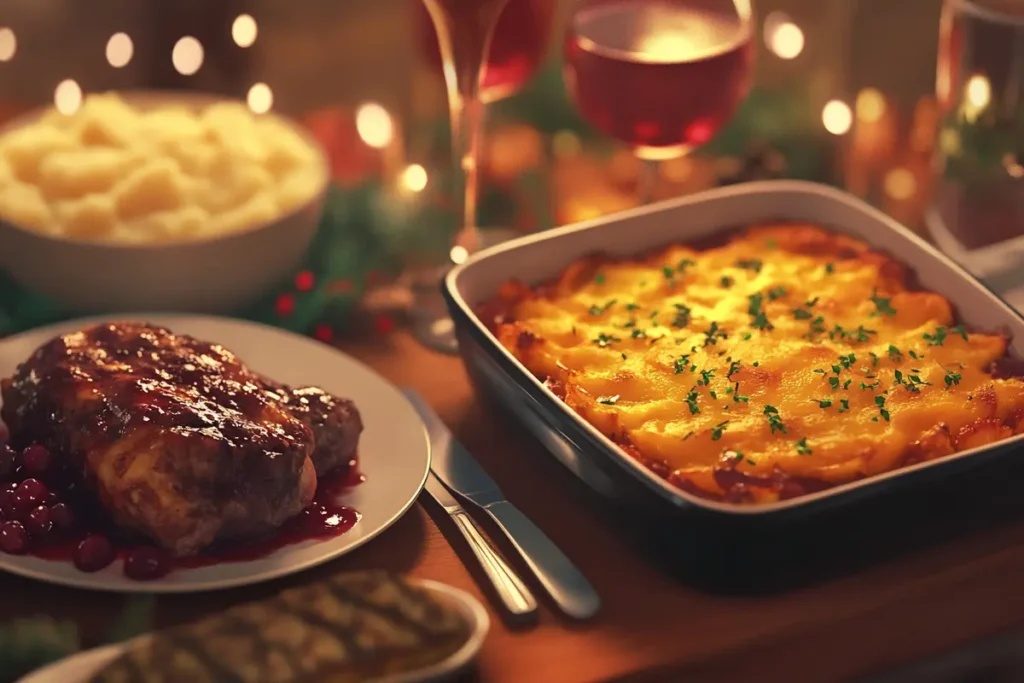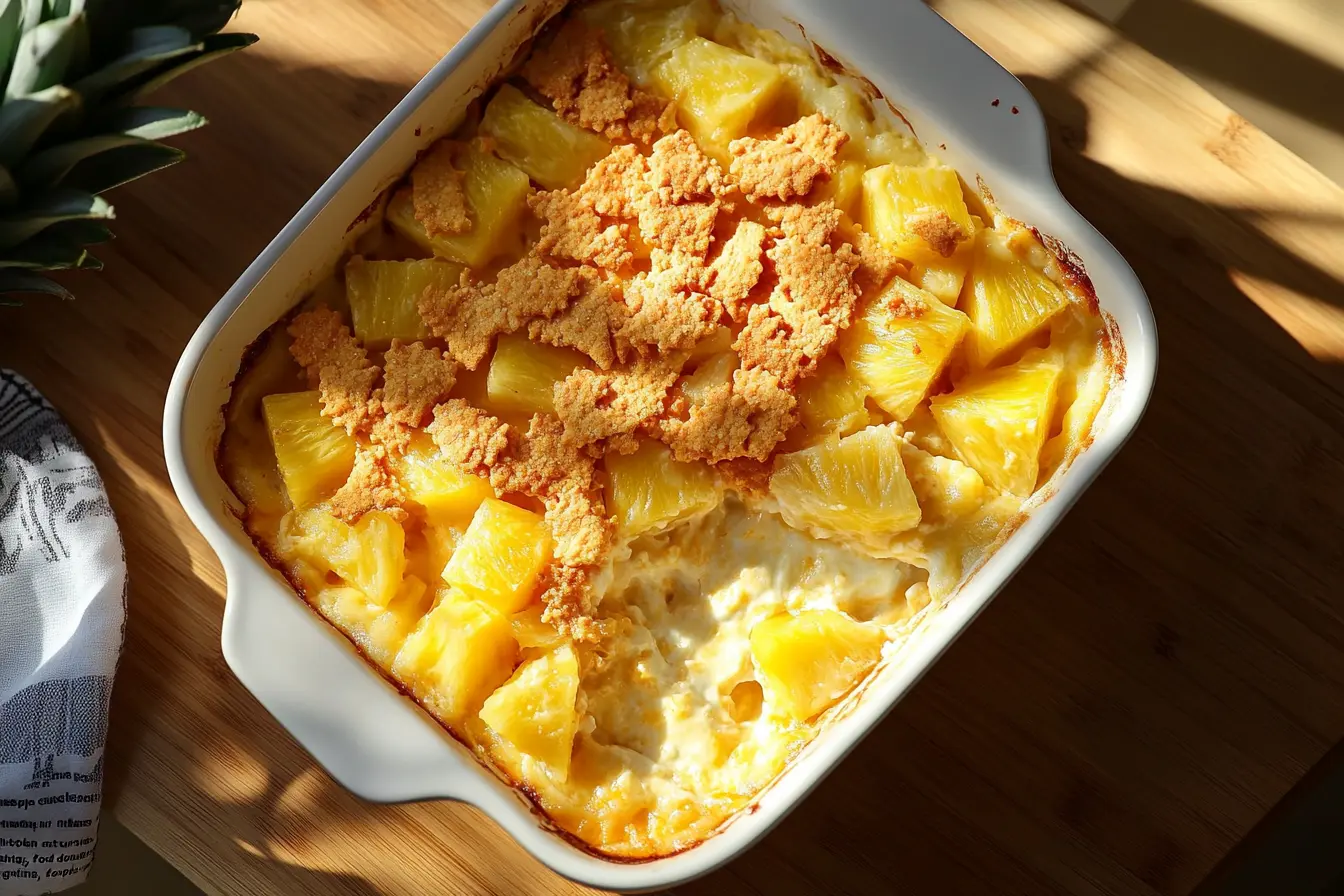If you’re looking for a unique dish that beautifully balances sweet and savory flavors, pineapple casserole with cheese might just be your next favorite recipe! This Southern classic blends juicy pineapple, sharp cheddar cheese, and a crispy, buttery topping to create a comforting side dish perfect for holidays, potlucks, or any family gathering.
In this article, you’ll discover everything you need to know about making the perfect pineapple casserole with cheese from scratch. We’ll explore its history, essential ingredients, step-by-step instructions, and variations to suit different tastes and dietary preferences. Whether you’re an experienced home cook or just looking for something new to try, this dish promises to be a hit on your dinner table!
Introduction to Pineapple Casserole with Cheese
What is Pineapple Casserole with Cheese?
Pineapple casserole with cheese is a retro Southern dish that combines sweet pineapple chunks with sharp cheddar cheese and a buttery cracker topping. At first glance, the mix of fruit and cheese might sound unusual—but one bite reveals an irresistible blend of flavors and textures. The juicy, tangy sweetness of the pineapple pairs surprisingly well with the creamy, slightly salty cheddar, while the crunchy cracker topping adds a delightful contrast.
This dish is often served as a side, but its dessert-like qualities make it versatile enough for both main courses and sweet finales. It’s a crowd-pleaser during Easter, Thanksgiving, and Christmas dinners, where classic comfort food takes center stage.
Origins and Popularity in Southern Cuisine
Pineapple casserole with cheese has its roots in mid-20th-century Southern cuisine, where home cooks loved experimenting with canned fruits and processed cheese. This dish likely emerged during a time when combining sweet and savory elements in a single dish became trendy. It was also a way to create budget-friendly meals using pantry staples.
Southern cooks embraced the combination for its simplicity and versatility. Over the years, it became a staple at church potlucks and family reunions, celebrated not just for its unique flavor but also for its ease of preparation. Today, it remains a nostalgic favorite, often passed down through generations as part of Southern culinary heritage.
Ingredients for the Best Pineapple Casserole
Core Ingredients for the Dish
To create the perfect pineapple casserole with cheese, you’ll need a few basic ingredients that come together beautifully for a sweet, savory, and slightly tangy experience:
- Pineapple Chunks: Use canned pineapple chunks for convenience, but fresh pineapple also works if drained properly.
- Sharp Cheddar Cheese: Aged cheddar adds a rich, tangy contrast to the sweet fruit.
- Sugar: Balances the tanginess and enhances the pineapple’s natural sweetness.
- All-Purpose Flour: Helps thicken the casserole base, ensuring a creamy texture.
- Butter: Melted butter combines with crackers for a deliciously crisp topping.
- Ritz Crackers: Crushed crackers give a perfect crunch on top.
These simple ingredients create a harmony of textures and flavors, making pineapple casserole with cheese a memorable side dish for holidays and potlucks.
Optional Additions and Variations for Enhanced Flavor
Want to experiment with your pineapple casserole with cheese? Here are some popular tweaks:
- Nuts: Pecans or walnuts add a delightful crunch.
- Coconut: Shredded coconut pairs well with pineapple for a tropical twist.
- Different Cheeses: Try Monterey Jack or Pepper Jack for a spicier version.
- Brown Sugar: Swap white sugar for a richer, caramel-like sweetness.
For a gluten-free version, use crushed gluten-free crackers and a gluten-free flour blend. Whether you stick to tradition or add a twist, the key to the perfect pineapple casserole with cheese lies in balancing sweetness, creaminess, and crunch.
How to Make Pineapple Casserole with Cheese – Step by Step

Preparation Steps and Baking Instructions
Making pineapple casserole with cheese is a breeze! Here’s how to prepare this comforting classic:
- Preheat and Prep: Preheat your oven to 350°F (175°C) and grease an 8×8-inch baking dish.
- Drain the Pineapple: Drain canned pineapple chunks thoroughly, reserving a bit of juice for moisture. Pat dry to avoid a watery casserole.
- Mix the Base: In a large bowl, combine drained pineapple, 1 cup of shredded sharp cheddar cheese, sugar, and flour. Mix until well coated.
- Layer the Dish: Pour the pineapple mixture into the prepared dish and spread evenly. Sprinkle the remaining cup of cheese on top.
- Prepare the Topping: Crush Ritz crackers and mix with melted butter. Spread this mixture evenly over the casserole.
- Bake: Place the casserole in the preheated oven and bake for 30-35 minutes or until the top is golden brown and bubbly.
- Cool and Serve: Let the casserole rest for 5-10 minutes before serving.
Tips for Achieving the Perfect Texture and Flavor
- Drain the Pineapple Properly: Excess juice can make the casserole soggy. Use a fine mesh sieve and paper towels.
- Use Freshly Shredded Cheese: Pre-shredded cheese contains anti-caking agents, which can affect melting quality.
- Even Topping: Spread the cracker topping evenly to ensure a consistent crunch.
This simple yet delicious pineapple casserole with cheese is perfect for any occasion. Try serving it alongside baked ham or roast chicken for a Southern-style feast!
Best Cheese Choices for Pineapple Casserole
Why Sharp Cheddar Works Best
When it comes to making the perfect pineapple casserole with cheese, sharp cheddar cheese is the top choice. Its bold, tangy flavor balances beautifully with the sweetness of the pineapple, creating that irresistible sweet-and-savory contrast the dish is known for.
Sharp cheddar also melts smoothly, giving the casserole a creamy texture without overpowering the fruit. The slight saltiness enhances the dish’s complexity, making every bite a flavorful experience.
Alternative Cheeses to Try
While sharp cheddar is the classic choice, other cheeses can work just as well depending on your taste preferences:
- Monterey Jack: Milder than cheddar with a creamy texture.
- Gouda: Offers a slightly nutty flavor for a richer twist.
- Mozzarella: Soft and stretchy but less tangy than cheddar.
- Pepper Jack: Adds a subtle kick of heat, perfect for those who like a bit of spice.
If you’re feeling creative, consider blending multiple cheeses for a more complex flavor profile. No matter which you choose, aim for cheeses that melt well and have a balance of saltiness and creaminess.
Pineapple casserole with cheese thrives on bold cheese choices that create contrast, making it a standout side dish for holiday dinners and potlucks.
Customizing Your Pineapple Cheese Casserole
Sweet vs. Savory Adjustments
One of the best things about pineapple casserole with cheese is its versatility. Whether you prefer it more on the sweet side or want to lean into the savory elements, there are easy ways to tweak the recipe.
For a sweeter version:
- Add a tablespoon of brown sugar for deeper caramel notes.
- Mix in a handful of sweetened coconut flakes.
- Use pineapple tidbits instead of chunks for a finer texture.
For a more savory twist:
- Reduce the sugar or omit it completely.
- Add a pinch of cayenne pepper or black pepper for heat.
- Try using herbed crackers instead of Ritz for a more complex topping.
Vegan and Gluten-Free Options
If you’re catering to specific dietary needs, this dish is easy to modify without losing its charm.
For a vegan version:
- Swap cheddar for vegan cheddar shreds.
- Use a dairy-free butter alternative.
For a gluten-free version:
- Substitute gluten-free crackers for the topping.
- Use a gluten-free flour blend as a thickening agent.
These adjustments ensure that everyone can enjoy a delightful serving of pineapple casserole with cheese, no matter their dietary preferences.
For more delicious Southern classics, check out this Pineapple Casserole Recipe for another twist on this comforting dish.
What to Serve with Pineapple Casserole with Cheese

Best Main Dishes to Pair With
Pineapple casserole with cheese shines as a side dish, thanks to its balance of sweet and savory flavors. It’s especially popular during holidays and family gatherings where hearty dishes take center stage. But what pairs best with this Southern classic?
- Glazed Ham: The sweetness of pineapple casserole with cheese perfectly complements the salty richness of a honey-glazed ham, making it ideal for Easter or Christmas dinners.
- Roast Chicken: Serve alongside roast chicken for a comforting meal with contrasting textures and flavors.
- Barbecue Pork Ribs: The tangy sweetness pairs beautifully with smoky, tender pork ribs.
- Fried or Baked Chicken: Southern-style fried chicken and pineapple casserole with cheese share a perfect balance of sweet and savory.
This casserole also works wonderfully with grilled meats, roasted turkey, and even seafood dishes like shrimp skewers, enhancing the overall dining experience with its unique twist.
Serving Ideas for Holidays and Potlucks
Whether you’re hosting a festive dinner or a casual potluck, pineapple casserole with cheese can be the star side dish. Here are some creative ways to serve it:
- Holiday Dinners: Present it alongside stuffing, mashed potatoes, and cranberry sauce for a balanced Thanksgiving spread.
- Potluck Favorite: Prepare it in a large baking dish for easy serving at family gatherings.
- Brunch Buffets: Serve warm alongside scrambled eggs and breakfast sausages for a sweet-salty twist at brunch.
This casserole’s vibrant flavors and ease of preparation make it a go-to dish for any event where comfort food is a must.
Storing and Reheating Pineapple Cheese Casserole
Proper Storage Tips for Freshness
Got leftovers? Pineapple casserole with cheese stores well, making it great for meal prepping or enjoying the next day. To keep it fresh:
- Refrigerate: Allow the casserole to cool completely before transferring it to an airtight container. It stays fresh in the fridge for up to 4 days.
- Freeze: For longer storage, freeze in a tightly sealed container for up to 2 months. However, the cracker topping may lose some crunch after thawing.
Best Methods for Reheating
Reheating pineapple casserole with cheese properly helps preserve its taste and texture. Follow these methods for the best results:
- Oven Method: Preheat your oven to 350°F (175°C). Cover the casserole with foil to prevent over-browning and bake for 15-20 minutes until heated through.
- Microwave Method: For smaller portions, reheat on medium power in 30-second bursts until warm.
- Air Fryer Method: Reheat individual portions in an air fryer for 5-7 minutes at 350°F, ensuring a crispy topping.
Pro Tip: If reheating frozen casserole, allow it to thaw in the refrigerator overnight before reheating for even results.
Pineapple casserole with cheese is best enjoyed fresh, but with the right storage and reheating techniques, you can savor its deliciousness for days!
FAQs about Pineapple Casserole with Cheese
Why Add Cheese to a Pineapple Casserole?
The idea of combining pineapple casserole with cheese might sound unusual, but the flavor contrast is what makes this dish so special. The sharp cheddar cheese balances the natural sweetness of the pineapple, creating a perfect blend of savory and sweet flavors. This contrast enhances the overall richness of the dish, making it ideal as both a side and a standalone comfort food.
The melted cheese also contributes to the dish’s creamy texture, especially when paired with the buttery cracker topping. This combination makes it a favorite for potlucks, holidays, and special gatherings.
Can You Prepare Pineapple Casserole Ahead of Time?
Absolutely! Pineapple casserole with cheese can be made ahead for added convenience. Here’s how:
- Prepare the Filling: Mix the pineapple, cheese, sugar, and flour as instructed.
- Assemble the Dish: Layer the mixture in a baking dish but leave the cracker topping off.
- Store: Cover the dish tightly with plastic wrap and refrigerate for up to 24 hours.
- Bake Fresh: Before baking, add the cracker topping and bake as directed.
This make-ahead option allows you to save time while ensuring the casserole stays delicious and fresh for your event.
Nutritional Information and Dietary Considerations
Caloric Breakdown and Nutritional Highlights
Pineapple casserole with cheese is a rich dish, so it’s best enjoyed in moderation. Here’s a rough breakdown per serving (based on an average recipe):
- Calories: ~280 kcal
- Protein: 5g
- Carbohydrates: 32g
- Fats: 14g
- Sugars: 18g
While this dish offers a good source of calcium from the cheese, it also contains added sugars and fats, which makes it more of an indulgent treat than an everyday meal.
Caloric Breakdown and Nutritional Content (Per 100g)
Pineapple casserole with cheese is undeniably a rich, indulgent dish. While it offers a delightful balance of sweet and savory flavors, being aware of its nutritional content helps with mindful eating. Here’s a detailed breakdown of the nutritional values per 100g serving:
| Nutrient | Amount (Per 100g) |
|---|---|
| Calories | 280 kcal |
| Protein | 5g |
| Carbohydrates | 32g |
| Sugars | 18g |
| Fats | 14g |
| Saturated Fat | 7g |
| Fiber | 1g |
| Calcium | 150mg |
Dietary Adjustments for Healthier Variations
If you’re looking to enjoy a lighter version of pineapple casserole with cheese, here are some simple swaps:
Reduced Sugar: Cut sugar in half or use natural alternatives like stevia or monk fruit.
Whole Wheat Crackers: Replace Ritz crackers with whole grain or gluten-free options.
Low-Fat Cheese: Opt for reduced-fat cheddar or part-skim mozzarella.
Vegan: Use dairy-free cheese, vegan butter, and a plant-based flour substitute.
These modifications can help make the dish healthier while still maintaining its comforting taste.
Dietary Adjustments for Healthier Variations
If you’re looking to make pineapple casserole with cheese a bit healthier, consider these adjustments:
- Lower Sugar: Reduce the sugar or replace it with a sugar alternative like monk fruit sweetener.
- Whole Wheat Crackers: Swap Ritz crackers for whole grain or gluten-free crackers.
- Light Cheese Options: Use part-skim cheddar or a blend of reduced-fat cheeses.
- Vegan Alternative: Use vegan cheddar, dairy-free butter, and a plant-based flour substitute.
These modifications can help reduce the calorie and fat content while still preserving the comforting taste of this Southern classic.

